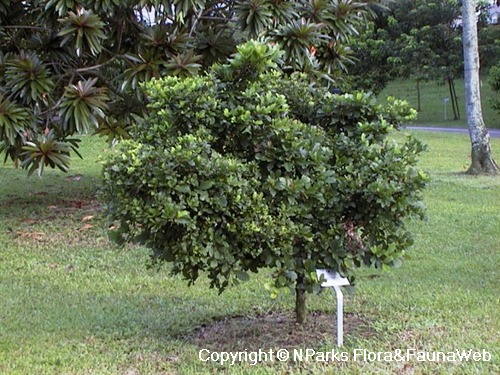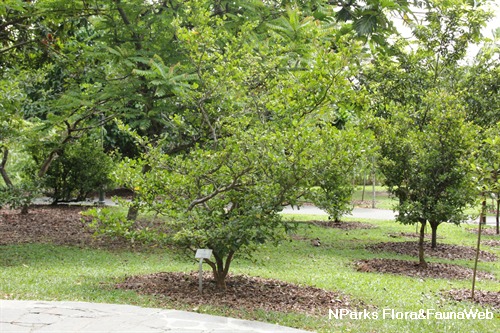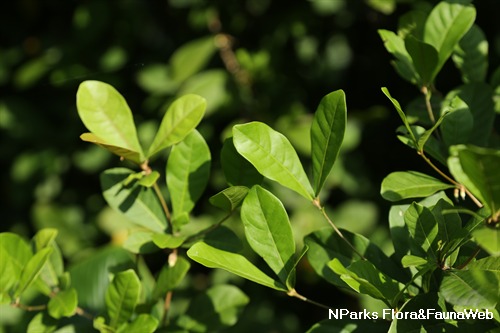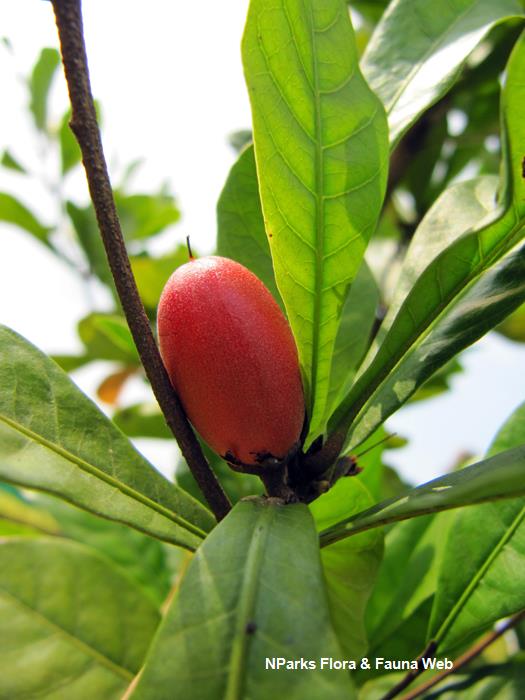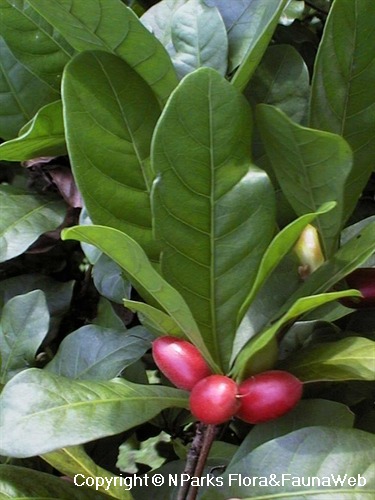
Back
Synsepalum dulcificum (Schumach. & Thonn.) Daniell
| Family Name: | Sapotaceae |
| Common Name: | Miracle Fruit, Miracle Berry, Miraculous Berry, Flavour Berry, Fruit Miraculeux, Fruit Milagroso, 神秘果 |
Name
Classifications and Characteristics
| Plant Division | Angiosperms (Flowering Seed Plants) (Dicotyledon) |
|---|---|
| Plant Growth Form | Shrub, Tree (Small (6m-15m), Shrubby (1m-5m)) |
| Lifespan (in Singapore) | Perennial |
| Mode of Nutrition | Autotrophic |
| Plant Shape | Oval |
| Maximum Height | 1 m to 3 m |
Biogeography
| Native Distribution | West Africa |
|---|
Description and Ethnobotany
| Others - Plant Morphology | Slow-growing big shrub or small bushy tree with oval crown, up to 6m height in native habitat, but usually much lower under cultivation. Flowers creamy-white, very small, held in clusters in leaf axils. Free-fruitng the whole year round. Fruits ripen from green to scarlet red, oval-shaped (9mm long), with a single seed embedded in edible, sweetish white pulp. Fruits contain miraculin, a taste-modifying, protein-based molecule that when eaten, makes sour or bitter food taste sweet, hence the species epithet 'dulcificum' -- meaning 'very sweet'.Grown for ornamental or economic purposes. Prefers well-drained acidic soils (pH 4.5 - 5.8). Seed-grown plants start bearing fruit at 2-3 years of age. Suitable as container plant for small gardens. |
|---|---|
| Ethnobotanical Uses | Edible Plant Parts : Edible Fruits Food (Herb or Spice) (Fruit or Vegetable) Others: In Africa where modern refrigeration is not available, fruits are tradtionally chewed before meals to make stale food taste better. |
Landscaping Features
| Landscape Uses | Container Planting, General |
|---|---|
| Thematic Landscaping | Economic Garden, Naturalistic Garden |
| Plant & Rootzone Preference or Tolerance Remarks | Prefers acidic soils of pH 4.8 - 5.5. |
Plant Care and Propagation
| Light Preference | Full Sun |
|---|---|
| Water Preference | Moderate Water |
| Plant Growth Rate | Slow |
| Rootzone Tolerance | Well-Drained Soils, Alkaline high pH Soils |
| Maintenance Requirements | Moderate |
| Potential Problems | Plant does not tolerate alkaline and waterlogged soils. |
| Propagation Method | Seed, Stem Cutting |
Foliar
| Mature Foliage Colour(s) | Green |
|---|---|
| Leaf Area Index (LAI) for Green Plot Ratio | 4.5 (Shrub & Groundcover - Dicot) |
Non - Foliar and Storage
| Trunk Type (Non Palm) | Woody |
|---|---|
| Stem Type & Modification | Woody |
| Root Type | Underground (Tap Root, Fibrous Root) |
Floral (Angiosperm)
| Flower Colour(s) | Cream / Off-White |
|---|---|
| Flowering Habit | Polycarpic |
Fruit, Seed and Spore
| Mature Fruit Colour(s) | Red |
|---|---|
| Fruit Classification | Simple Fruit |
| Fruit Type | Fleshy Fruit , Berry |
Image Repository
Others
| Master ID | 1859 |
|---|---|
| Species ID | 3152 |
| Flora Disclaimer | The information in this website has been compiled from reliable sources, such as reference works on medicinal plants. It is not a substitute for medical advice or treatment and NParks does not purport to provide any medical advice. Readers should always consult his/her physician before using or consuming a plant for medicinal purposes. |

